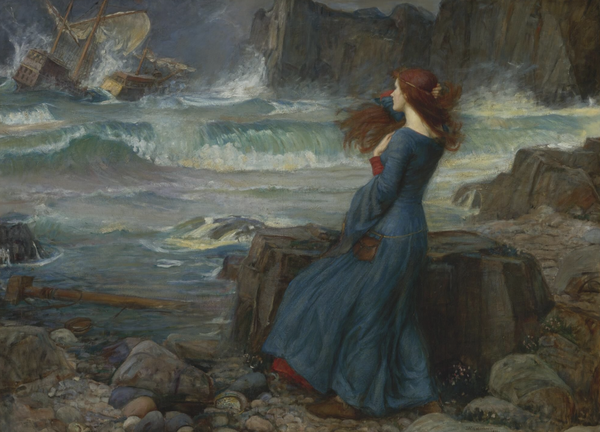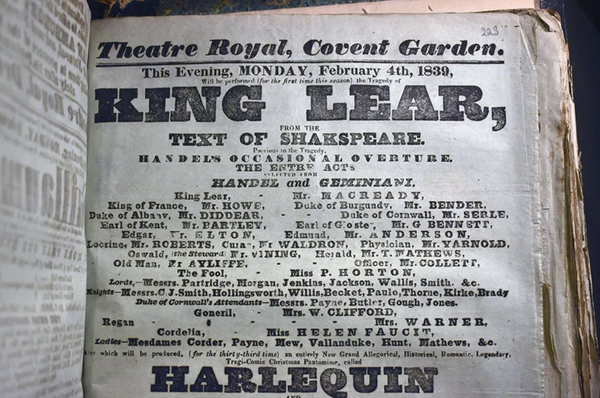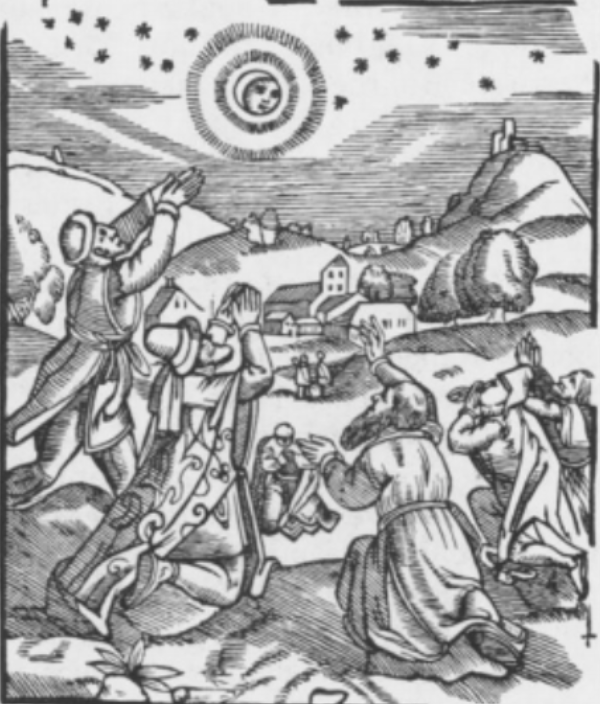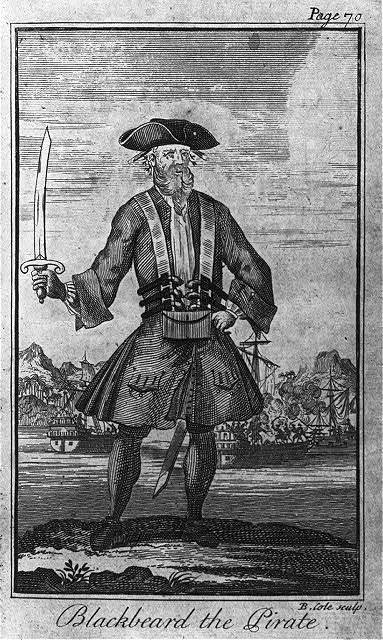Volume 15: January 20, 2021
Macbeth, King Lear, and the Gunpowder Plot
By London Johns
In the fall of 1605, William Parker, a member of the House of Lords, received an anonymous letter instructing him to refrain from attending Parliament the next day. “God and man hath concurred to punishe the wickedness of this tyme,” the letter said, and Parliament was going to suffer a “terrible blow” from an unseen enemy (“The Monteagle Letter”). The Parliament building was searched, and Guy Fawkes was found in the cellar next to a stash of gunpowder. Several other conspirators were soon discovered and arrested. Guy Fawkes was tortured for information; eight men were executed for their involvement. The Gunpowder Plot inspired many authors to compose works in response, and Shakespeare was no exception. The plays that Shakespeare wrote in the years following the plot demonstrated support for King James’s response, but also sympathy for Catholics who were not involved in the plot but nevertheless forced to suffer its consequences.
The Gunpowder Plot was the Catholic response to anti-Catholic actions by England’s Protestant government. When James I became king after Elizabeth I’s death in 1603, Catholics hoped that he would ease religious tension, but their hopes were soon dashed -- though James had Catholic family and wrote about tolerance of Catholicism (he was cautious of hurting “the innocent...as guiltie persons”), anti-Catholic sentiment in the House of Commons and a series of Catholic plots prior to 1605 caused him to gradually lose interest in making peace with Catholicism (qtd. In Nina Taunton and Valerie Hart 701; “James I - Peace with Spain.”). The Gunpowder Plot was an attempt to kill James I and the rest of the Protestant government contained in the Parliament building and replace James I with a Catholic ruler. The plan backfired -- the failed plot resulted in increased suspicion towards and persecution of Catholics.
King Lear was probably the first of Shakespeare’s plays written after the Gunpowder Plot. Its earliest known performance was in the winter of 1606, only a year after the plot, but it may have been written earlier -- possibly as early as 1603 (Nina Taunton and Valerie Hart 698). Aspects of the play align with the plot, though it is unclear whether all of its references are intentional. Gloucester, when speaking with Edmund about astrology, blames “eclipses in the Sunne and Moone” for outbreaks of “in cities, mutinies; in countries, discord; in palaces, treason” (Shakespeare, King Lear 1.2.113-114). If the eclipses Gloucester mentions refer to real eclipses of the moon and the sun in the fall of 1605, the “treason” Gloucester speaks of could be the Gunpowder Plot, which occurred only a month later. However, E. K. Chambers, who pointed to the eclipses as a possible method of determining the date of the play’s first performance, noted that while Gloucester’s phrase “these late eclipses” suggests that the eclipses have already passed, these astronomical events were anticipated since 1588, and it is possible that King Lear was written before they actually occurred. Moreover, the reference to mutinies, discords, and treason was not specific enough to assume an allusion to the Gunpowder Plot (Taunton 697; Chambers 468).
More explicit references to the plot can be found in Macbeth, the next play written by Shakespeare. Beyond the obvious similarities between the plot of Macbeth and the Gunpowder Plot -- the assassination of a king, secret treasonous plans -- some imagery used in Macbeth described images created to acknowledge its discovery. In 1605, a silver medal was made in Holland to commemorate the plot’s failure. It showed a snake curled in the center of a ring of flowers, representing the deception of the perpetrators. The Latin inscription in the medal translated to “he, who concealed himself, is detected. By order of the Senate” (“Silver Medal Commemorating…”). In Act I Scene V of Macbeth, when Lady Macbeth and Macbeth first speak of the plan to murder Duncan, Lady Macbeth urges Macbeth to “Look like th' innocent flower,/But be the serpent under 't” (Shakespeare, Macbeth 1.6.76-77); early audiences watching Macbeth would be aware of the medal and understand that Lady Macbeth was suggesting that they commit treason.
The second clear reference to the events of 1605 in Macbeth is spoken by the Porter. He criticizes an “equivocator”:
“Faith, here's an equivocator, that could swear in both the scales against either scale;
who committed treason enough for God's sake, yet could not equivocate to heaven: O,
come in, equivocator.” (Shakespeare, Macbeth 2.3.6-10)
Equivocator in this context refers to Jesuits who, faced with the choice to lie -- which was a sin -- or admit to Catholicism in court and risk punishment, instead decided to phrase their defense as misleading in a way that suggested their innocence. One kind of equivocation consisted of statements that were partly spoken aloud, partly thought. Because God was supposedly aware of thoughts as well as spoken words, He was able to understand the entire (both spoken and unspoken) statement instead of the incomplete (spoken) statement, so the equivocator could avoid committing the sin of lying without incriminating himself (Huntley 392). One 1607 book that defended equivocation in certain situations, A treatise tending to mitigation tovvardes Catholike-subiectes in England, gave examples of cases in which it is acceptable to equivocate, including those in which a person is asked to defend him or herself against an unlawful court. In this situation, the defendant could say out loud “I haue not done it” while thinking “so as by right and law I am bound to vtter it vnto yow” (Parsons 419), thus avoiding both a lie and a confession.
This kind of reasoning was supposedly used by Father Henry Garnette, a Catholic priest executed for involvement in the conspiracy, at his trial. (The Porter’s “farmer, that hanged/himself on the expectation of plenty” likely also refers to Garnette, who used “farmer” as a pseudonym.) (Shakespeare, Macbeth 2.3.4-5; “The Trial of Henry Garnet”) While many Catholics defended equivocation as not only necessary but religiously defensible, Protestant authorities thought of it as tantamount to lying. In a 1606 letter, an English diplomat wrote that at Father Garnett’s approaching execution, “he will equivocate at the gallows; but he will be hanged without equivocation” (Huntley 390). The Porter seemed to think along the same lines. While equivocation might protect equivocators from the judgement of the court, it could not protect them from the judgement of God; they had still “committed treason enough for God's sake yet could not equivocate to heaven” (Shakespeare, Macbeth 2.3.10-11). As the Gentlewoman said about Lady Macbeth: “Heaven knows what she has known” (Shakespeare, Macbeth 5.1.51-52). The use of intentionally misleading language reoccurs throughout Macbeth, often by speaking one half of a truth and leaving the other unspoken. The witches, for instance, prophesize that “none of woman born/Shall harm Macbeth” (Shakespeare, Macbeth 4.1.90-92); in this case the unspoken half of the prophecy is that someone born by cesarean section will harm him. The initial predictions of the Witches in the first act of the play were also equivocation; the spoken line “all hail, Macbeth, that shalt be king hereafter” contains the unspoken condition ‘if you murder the current king’ (Shakespeare, Macbeth 1.3.53).
Though it is used primarily by murderers and supernatural forces, equivocation is not only used for evil purposes in Macbeth. Macbeth’s subjects, terrified to speak their minds, instead utter “curses, not loud but deep, mouth-honour, breath,/Which the poor heart would fain deny, and dare not” (qtd. in Huntley 399). Aloud, they praise Macbeth’s leadership, but they silently curse him in their thoughts; their spoken ideas have an unspoken second half. Macbeth’s subjects equivocate to avoid danger, like Catholics who equivocated in court for their own protection. The conversation between Lady Macduff and her son also references equivocation in the trials of the perpetrators of the Gunpowder Plot:
“Son: What is a traitor?
Lady Macduff: Why, one that swears and lies.
Son: And be all traitors that do so?
Lady Macduff: Every one that does so is a traitor and must be hanged.” (Shakespeare,
Macbeth 4.2.53-57)
“Traitors” being “hanged” would remind audiences of the plotters’ recent executions; by “swears and lies”, Lady Macduff could be referring to lying under oath. Macduff is a traitor criticized by his family for equivocation, but he has both an honorable cause and -- as he plans to restore peace “with Him above to ratify the work” -- a devotion to God, instead of to the devil, like the Witches do (qtd. in Huntley 399). Though Macduff and Macbeth’s subjects use the same method as the Witches, their use of it does not cause the same evil. Shakespeare did not categorically condemn equivocation in Macbeth, but demonstrated honorable and dishonorable uses of it.
Shakespeare had plenty of reason to use Macbeth to flatter King James. James had just become king, and had given Shakespeare’s acting company his patronage (Williams 12). However, the allusions to the Gunpowder Plot were not just intended to appeal to the King, but to communicate a subtle combination of empathy for innocent people suffering because of a crime they did not commit and condemnation of the true perpetrators.
Works Cited
Chambers, E. K. William Shakespeare: A Study Of Facts And Problems. I, Clarendon Press,
1963, Archive.org,
archive.org/details/williamshakespea017475mbp/page/n5/mode/2up?q=eclipse.
Huntley, Frank L. “Macbeth and the Background of Jesuitical Equivocation.” PMLA, vol. 79, no.
4, 1964, pp. 390–400. JSTOR, www.jstor.org/stable/460744. Accessed 20 Jan. 2021.
“James I - Peace with Spain.” UK Parliament, UK Parliament , 2021,
www.parliament.uk/about/living-heritage/evolutionofparliament/parliamentaryauthority/th
e-gunpowder-plot-of-1605/overview/background-to-the-gunpowder-plot/peacemaker---th
e-new-king/.
Parsons, Robert. A Treatise Tending to Mitigation Tovvardes Catholike-Subiectes in England.
Saint-Omer: Printed by F. Bellet, 1607. Early English Books Online Text Creation Partnership, quod.lib.umich.edu/e/eebo/A09111.0001.001/1:14?rgn=div1;view=toc.
Passe, Crispijn de. “The Gunpowder Plot Conspirators.” National Portrait Gallery, National
Portrait Gallery,
www.npg.org.uk/collections/search/portrait/mw00381/The-Gunpowder-Plot-Conspirators-1605.
Shakespeare, William. King Lear. Edited by Barbara Mowat and Paul Werstine, Folger
Shakespeare Library, The Folger Shakespeare, shakespeare.folger.edu/.
Shakespeare, William. Macbeth. Edited by Barbara Mowat and Paul Werstine, Folger
Shakespeare Library, The Folger Shakespeare, shakespeare.folger.edu/.
“Silver Medal Commemorating the Discovery of the Gunpowder Plot.” The British Library, The
British Library, 26 Nov. 2015, www.bl.uk/collection-items/gunpowder-plot-medal.
Taunton, Nina, and Valerie Hart. “‘King Lear’, King James and the Gunpowder Treason of 1605.”
Renaissance Studies, vol. 17, no. 4, 2003, pp. 695–715. JSTOR, www.jstor.org/stable/24413716. Accessed 20 Jan. 2021.
“The Monteagle Letter.” Received by William Parker, The National Archives, The National Archives, 1605, www.nationalarchives.gov.uk/education/resources/gunpowder-plot/source-1/.
“The Trial of Henry Garnet, 1606.” The British Library, The British Library, 23 Sept. 2015, www.bl.uk/collection-items/the-trial-of-henry-garnet-1606.
Williams, George Walton. “‘Macbeth’: King James's Play.” South Atlantic Review, vol. 47, no. 2, 1982, pp. 12–21. JSTOR, www.jstor.org/stable/3199207. Accessed 20 Jan. 2021.







